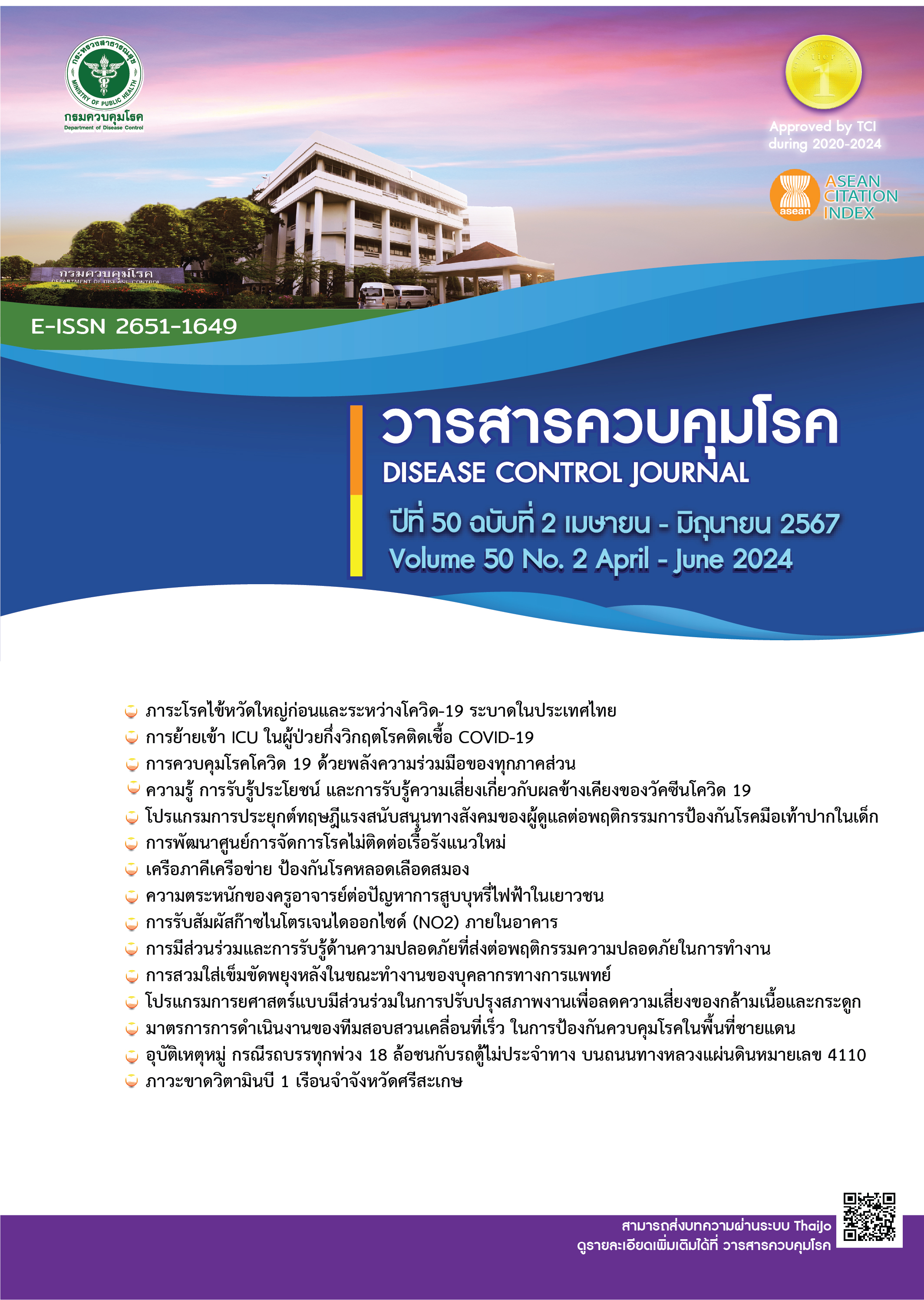ปัจจัยที่มีความสัมพันธ์กับการย้ายเข้า ICU ในผู้ป่วยกึ่งวิกฤตโรคติดเชื้อ COVID-19: การศึกษาการระบาดในระยะที่ 3
DOI:
https://doi.org/10.14456/dcj.2024.17คำสำคัญ:
ผู้ติดเชื้อโควิด 19, การรักษาในหอผู้ป่วยวิกฤต, ปัจจัยที่มีความสัมพันธ์บทคัดย่อ
จากสถานการณ์การระบาดของโรคติดเชื้อ COVID-19 พบผู้ป่วยที่จำเป็นต้องย้ายเข้ารักษาในหอผู้ป่วยวิกฤต (intensive care unit: ICU) ซึ่งมีหลายปัจจัยที่มีความสัมพันธ์ การศึกษานี้มีวัตถุประสงค์เพื่อวิเคราะห์ปัจจัยที่มีความสัมพันธ์กับการย้ายเข้า ICU ในผู้ป่วยติดเชื้อ COVID-19 ที่เข้ารับการรักษาในหอผู้ป่วยกึ่งวิกฤตในการระบาดระยะที่ 3 จำนวน 439 ราย ระหว่าง 1 พฤษภาคม ถึง 30 กันยายน 2564 คัดออก 15 ราย เนื่องจากเสียชีวิตที่หอผู้ป่วยกึ่งวิกฤต คงเหลือกลุ่มตัวอย่าง 424 ราย วิเคราะห์ข้อมูลด้วยสถิติเชิงพรรณนา และการถดถอยลอจิสติกพหุคูณ นำเสนอด้วยค่า Adjusted Odds Ratio (aOR) ที่ช่วงความเชื่อมั่น 95% ผลการศึกษาพบผู้ป่วยกึ่งวิกฤตโรคติดเชื้อ COVID-19 เป็นเพศชาย 207 ราย (ร้อยละ 48.8) อายุเฉลี่ย 59.8 ปี (SD=16.05) ผู้ป่วย 75 ราย (ร้อยละ 17.7) ย้ายไป ICU และ 349 ราย (ร้อยละ 82.3) ไม่ได้ย้ายเข้า ICU ปัจจัยที่มีความสัมพันธ์กับการย้ายเข้า ICU ได้แก่ ผู้ป่วยที่ทำ awakening prone (aOR 1.88; 95% CI; 1.01-3.51) และค่าความเข้มข้นของออกซิเจน (FiO2) มากกว่า 0.6 (aOR 8.32; 95% CI; 4.36-15.86) ผลการศึกษานี้สามารถนำไปเป็นข้อมูลสนับสนุน เพื่อหาวิธีลดอัตราการเข้า ICU โดยไม่ได้วางแผน และเฝ้าระวังในผู้ป่วยที่มีความเสี่ยงสูง เพื่อให้ผู้ป่วยได้รับการดูแลอย่างมีคุณภาพ และมีประสิทธิภาพสูงยิ่งขึ้น
Downloads
เอกสารอ้างอิง
World Health Organization and the United Nations Development Programme. Uniatf policy-brief NCDs and COVID final [Internet]. 2020 [cited 2022 Jan 21]. Available from: https://cdn.who.int/media/docs/default-source/thailand/ncds/uniatf_policy-brief_ncds-and-covid_final_th.pdf?sfvrsn=5c166f07_3.
Berlin DA, Gulick RM, Martinez FJ. Severe COVID-19. N Engl J Med 2020;383(2):2451-60.
Department of Disease Control (TH). Emergency operations center, Department of disease control. Thailand weekly situation update on 26 September 2021 [Internet]. 2021 [cited 2022 Aug 26]. Available from: https://ddc.moph.go.th/viralpneumonia/file/situation/situation- no631-250964.pdf (in Thai)
Centers for Disease Control and Prevention. Interim clinical guidance for management of patients with confirmed coronavirus disease (COVID-19) [Internet]. 2020 [cited 2021 Jan 10]. Available from: https://www.cdc.gov/coronavirus/2019-ncov/hcp/clinical-guidance-management -patients.html
Manmana S, Iamsirithaworn S, Uttayamakul S. Coronavirus Disease-19 (COVID-19). Bamrasnaradura Infect Dis Inst 2020;14(2):1-10. (in Thai)
Ungchusak K. Overview of field epidemiology [Internet]. 2019 [cited 2022 Jan 21]. http://www.interfetpthailand.net/th/file/June2019/pdf/wk1_Dr_kumnuan_17June.pdf.
Thanakijtummakul N. Nursing care for COVID-19 patients with acute respiratory distress syndrome. JTNMC 2021;36(3);16-30.
Naorungroj T, Viarasilpa T, Tongyoo S, Detkaew A, Pinpak T, Wimolwattanaphan R, et al. Characteristics, outcomes, and risk factors for in-hospital mortality of COVID-19 patients: A retrospective study in Thailand. Front Med 2022;9:1061955:1-11.
Du W, Yu J, Wang H, Zhang X, Zhang S, Li Q, et al. Clinical characteristics of COVID 19 in children compared with adults in Shandong Province, China. Infection 2020;48:445-52.
Ludvigsson JF. Systematic review of COVID-19 in children shows milder cases and a better prognosis than adults. Acta Paediatrica 2020;109:1088-95.
Suwalapha C, Yongprawat T, Charoengid W, Laongam P. Experience in the Cohort intermediate care unit arrangement and nursing management of patients with COVID-19 at Bangkok Hospital Headquarters. BKKMEDJ 2021;17(2):161-9.
Suarez-Cuartin G, Gasa M, Bermudo G, Ruiz Y, Hernandez-Argudo M, Marin A, et al. Clinical outcomes of severe COVID-19 patients admitted to an intermediate respiratory care unit. Front Med 2021;8(711027):1-10.
Gasa M, Ruiz-Albert Y, Cordoba-Izquierdo A, Sarasate M, Cuevas E, Suarez-Cuartin G, et al. Outcomes of COVID-19 patients admitted to the intermediate respiratory care unit: Non-invasive respiratory therapy in a sequential protocol. Int J Environ Res Public Health 2022;19(17):1-19.
Accordino S, Canetta C, Bettini G, Corsico F, Ghigliazza G, Barbetta L, et al. Clinical characteristics and outcomes of patients with acute respiratory failure due to SARS-CoV-2 interstitial pneumonia treated with CPAP in a medical intermediate care setting: A retrospective observational study on comparison of four waves. J Clin Med 2023;12(4):1-11.
Matute‑Villacis M, Moises J, Embid C, Armas J, Fernandez I, Medina M, et al. Role of respiratory intermediate care units during the SARS‑CoV-2 pandemic. BMC Pulm Med 2021;21(228):1-7.
Wu Z, McGoogan JM. Characteristics of and important lessons from the Coronavirus Disease 2019 (COVID-19) outbreak in China: Summary of a report of 72,314 cases from the Chinese center for disease control and prevention. JAMA 2020;323(13):1239-42.
Bhaskaran K, Rentsch CT, MacKenna B, Schultze A, Mehrkar A, Bates CJ, et al. HIV infection and COVID-19 death: a population-based cohort analysis of UK primary care data and linked national death registrations within the OpenSAFELY platform. Lancet HIV 2021;8:e24-32.
Zhou F, Yu T, Du R, Fan G, Liu Y, Liu Z, et al. Clinical course and risk factors for mortality of adult inpatients with COVID-19 in Wuhan, China: a retrospective cohort study. The Lancet 2020;395(10229):1054-62.
Pandit RA, Gagana BN, Vaity C, Mulakavalupil B, Choudhary JS, Jain V, et al. Clinical characteristics and outcomes of COVID-19 patients hospitalized in intensive care unit. Indian J Crit Care Med 2021;25(9):992-1000.
Deng G, Yin M, Chen X, Zeng F. Clinical determinants for fatality of 44,672 patients with COVID-19. Critical care 2020;24(179):1-3.
Williamson EJ, Walker AJ, Bhaskaran K, Bacon S, Bates C, Morton CE, et al. OpenSAFELY: Factors associated with COVID-19-related death using Nature 2020;584(7821):430-6.
Lavin W, Yooyadmak P, Phenglai C. Risk of mortality among COVID-19 patients admitted to intermediate ICU: A study during the third wave of COVID-19 pandemic. Dis Control J 2023;49(1):11-20.
Adams JY, Rogers AJ, Schuler A, Marelich GP, Fresco JM, Taylor SL, et al. Association between peripheral blood oxygen saturation (SpO2)/ Fraction of inspired oxygen (FiO2) ratio time at risk and hospital mortality in mechanically ventilated patients. Perm J 2020;24(19.113):1-7.
Papazian L, Aubron C, Brochard L, Chiche JD, Combes A, Dreyfuss D, et al. Formal guidelines: management of acute respiratory distress syndrome. Ann Intensive Care 2019;9(1):69.
Yoriya E. Critical care nursing to reduce complications from prone position in ARDS patients. TRC Nurs J 2020;13(2):62-73.
Rahmani F, Salmasi S, Rezaeifar P. Prone position effects in the treatment of COVID-19 patients. Caspian J Intern Med 2020;11(1):S580-2.
Claudia G, Daniel K, Sebastiana H, Anna C, Christoph AF, Beat M, et al. Characteristics, predictors and outcomes among 99 patients
hospitalised with COVID-19 in a tertiary care centre in Switzerland: an observational analysis. Swiss Med Wkly 2020;150:w20316:1-7.
Sabetian G, Azimi A, Kazemi A, Hoseini B, Asmarian N, Khaloo V, et al. Prediction of patients with COVID-19 requiring Intensive Care: A cross-sectional study based on machine-learning approach from Iran. Indian J Crit Care Med 2022;26(6):688-95.
ดาวน์โหลด
เผยแพร่แล้ว
รูปแบบการอ้างอิง
ฉบับ
ประเภทบทความ
สัญญาอนุญาต
ลิขสิทธิ์ (c) 2024 วารสารควบคุมโรค

อนุญาตภายใต้เงื่อนไข Creative Commons Attribution-NonCommercial-NoDerivatives 4.0 International License.
บทความที่ลงพิมพ์ในวารสารควบคุมโรค ถือว่าเป็นผลงานทางวิชาการหรือการวิจัย และวิเคราะห์ตลอดจนเป็นความเห็นส่วนตัวของผู้เขียน ไม่ใช่ความเห็นของกรมควบคุมโรค ประเทศไทย หรือกองบรรณาธิการแต่ประการใด ผู้เขียนจำต้องรับผิดชอบต่อบทความของตน






